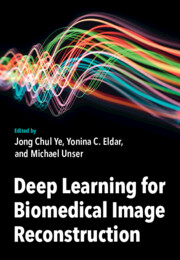Book contents
- Frontmatter
- Dedication
- Contents
- List of Contributors
- Preface
- Part I Theory of Deep Learning for Image Reconstruction
- 1 Formalizing Deep Neural Networks
- 2 Geometry of Deep Learning
- 3 Model-Based Reconstruction with Learning: From Unsupervised to Supervised and Beyond
- 4 Deep Algorithm Unrolling for Biomedical Imaging
- Part II Deep-Learning Architecture for Various Imaging Architectures
- Part III Generative Models for Biomedical Imaging
2 - Geometry of Deep Learning
from Part I - Theory of Deep Learning for Image Reconstruction
Published online by Cambridge University Press: 15 September 2023
- Frontmatter
- Dedication
- Contents
- List of Contributors
- Preface
- Part I Theory of Deep Learning for Image Reconstruction
- 1 Formalizing Deep Neural Networks
- 2 Geometry of Deep Learning
- 3 Model-Based Reconstruction with Learning: From Unsupervised to Supervised and Beyond
- 4 Deep Algorithm Unrolling for Biomedical Imaging
- Part II Deep-Learning Architecture for Various Imaging Architectures
- Part III Generative Models for Biomedical Imaging
Summary
Since the groundbreaking performance improvement by AlexNet at the ImageNet challenge, deep learning has provided significant gains over classical approaches in various fields of data science including imaging reconstruction. The availability of large-scale training datasets and advances in neural network research have resulted in the unprecedented success of deep learning in various applications. Nonetheless, the success of deep learning appears very mysterious. The basic building blocks of deep neural networks are convolution, pooling, and nonlinearity, which are primitive tools of mathematics. Interestingly, the cascaded connection of these primitive tools results in superior performance over traditional approaches. To understand this mystery, one can go back to the basic ideas of the classical approaches to understand the similarities and differences from modern deep-neural-network methods. In this chapter, we explain the limitations of the classical machine learning approaches, and provide a review of mathematical foundations to understand why deep neural networks have successfully overcome their limitations.
- Type
- Chapter
- Information
- Deep Learning for Biomedical Image Reconstruction , pp. 13 - 27Publisher: Cambridge University PressPrint publication year: 2023



